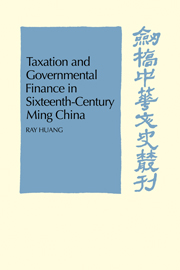Book contents
- Frontmatter
- Contents
- List of figures
- List of tables
- Preface by D. C. Twitchett
- Acknowledgements
- A note on weights and measures
- The Ming emperors
- Map of Ming provinces
- 1 Fiscal organization and general practices
- 2 The heritage of the sixteenth century and major fiscal problems
- 3 The land tax—(i) Tax structure
- 4 The land tax—(ii) Tax administration
- 5 The salt monopoly
- 6 Miscellaneous incomes
- 7 Financial management
- 8 Concluding observations
- List of abbreviations
- Appendixes
- Notes to the text
- Bibliography
- Glossary index
- General index
3 - The land tax—(i) Tax structure
Published online by Cambridge University Press: 04 August 2010
- Frontmatter
- Contents
- List of figures
- List of tables
- Preface by D. C. Twitchett
- Acknowledgements
- A note on weights and measures
- The Ming emperors
- Map of Ming provinces
- 1 Fiscal organization and general practices
- 2 The heritage of the sixteenth century and major fiscal problems
- 3 The land tax—(i) Tax structure
- 4 The land tax—(ii) Tax administration
- 5 The salt monopoly
- 6 Miscellaneous incomes
- 7 Financial management
- 8 Concluding observations
- List of abbreviations
- Appendixes
- Notes to the text
- Bibliography
- Glossary index
- General index
Summary
Land taxes in the late Ming period were undeniably as complex as personal income tax in the twentieth-century United States, if not more so. Presentday income tax is complex because the schedule has to deal with numerous special cases, of which the upper income group is the most complicated of all. The complexities of the Ming system, however, applied to all taxpayers, to owners of 5 mou and 5,000 mou of land alike. This makes the tax structure most difficult to describe. Furthermore even though tax regulations at the local level under the Ming followed a general pattern, there were numerous internal variations between one prefecture and another and sometimes even among counties in the same prefecture.
The conventional way to examine a specific financial institution is to start with a schematic presentation, explaining the terminology and presenting diagrams. This approach has not been completely abandoned. (The main features of the land tax system have already been enumerated (1, II) and in Fig. 3, they are presented diagrammatically.) But it has its limitations in dealing with the Ming taxation system. A more detailed investigation of the problem would soon show that there is no way of citing all the varieties and exceptions which occurred. In these circumstances generalizations could easily be misleading.
This section therefore proceeds in the following order: first the tax regulations of a selected county are described and the causes of their complexities traced.
- Type
- Chapter
- Information
- Publisher: Cambridge University PressPrint publication year: 1975



